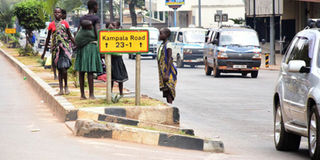How Karimojong parents fuel begging on Kampala streets

Karimojong children wait for stationary traffic in order to beg on Jinja Road in Kampala on April 5. PHOTO BY EDGAR BATTE
NAPAK- In 2001, Esther Acia was taken to Kampala at the age of seven by her cousin sister, purportedly to work as a maid.
On arrival, however, the purpose for which she was brought to the city soon changed.
“When we reached Kampala, I was taken to some street where children beg for women. These women place their babies in boxes. As the children are crying, some people would then stop and give us money but it is these women who benefit from the money,” she told Daily Monitor from Kobulin resettlement camp, Napak District, yesterday.
In 2003, Acia, who was then in Primary Three, escaped and returned to her Labok home village in Napak. She returned to school but after sitting Primary Leaving Examinations (PLE) in 2009, she again under mysterious circumstance went back to Kampala with other girls to beg.
“I used to move to either Busia or Kampala to beg and I used the money for paying my school fees,” she said.
Acia’s story is a reflection of many children who have over the years been travelling more than 460km to Kampala to either beg for money or work as maids.
Mr Mark Orugeny, a parent, says many children are being encouraged to move to Kampala to beg by their mothers.
“In most cases, women escape with the children in the absence of their husbands and move to other places. When they leave Karamoja, children are made to work in other people’s gardens or as housemaids and sometimes as sex slaves,” he says.
Gifts for parents
The money they generate from these unsustainable ventures helps them to purchase items such as mattresses and cooking utensils for their parents back home in Karamoja.
Social workers say parents feel happy and proud when their children offer them such gifts upon return from the city.
A counsellor with the Institute for International Cooperation and Development, Mr Moses Kalle Olum, says among the Karimojong, simply mentioning that your child is in the city is enough to silence a neighbour.
“The community members treat migration as a business and they always know where their children are going. The children buy mattresses, boxes, bags and cooking utensils for their parents back home and sometimes they send mobile money to their parents,” he says.
However, while in the city, the young people do all sorts of things to make ends meet. Majority of them stay around Kisenyi, a low scale city suburb, sorting agricultural produce such as maize and beans, Mr Olum says.
According to a 2010 article published in the journal White Horse Press titled ‘Nowhere to go: Karimojong displacement and forced resettlement,’ five months after the start of cordon-and-search operations in Karamoja in 2006, Karimojong, mainly women and children, moved to the streets of major towns in Uganda in large numbers to beg.
For the majority who moved to Kampala, the displacement did not prove to be of much help.
Today, Karimojong still find their way to Kampala and Nairobi to look for opportunities. Mr Jeremiah Abura, the Napak District vice chairperson, says peer influence is motivating children to go to the cities. He says teenage girls who move to Nairobi often link up with friends at the Busia border.
“When they come back from Nairobi, their general lifestyle changes and they try now to lure others for opportunities in the city,” Mr Abura says.
Peer influence
Social workers agree that parents are often convinced to allow their children move to Kampala or Nairobi when neighbours’ children start speaking different languages and wearing decent clothes upon return.
Mr Simon Peter Lemukol from the Community Development Office in Lorengecora Town Council, Napak District, says they lost six children that were knocked dead in traffic accidents in Kampala last year. The victims had not yet mastered the style of crossing the busy streets.
“Six people have died due to out-migration in a span of one year from Lorengecora Town Council alone. In fact, last month, there was one they brought; we just buried him. He died in a motor accident,” he says.
Mr Lemukol says the children are no longer out-migrating from Karamoja in large numbers.
“We have liaised with the police to make sure whoever is involving himself or herself in child trafficking or encouraging out-migration is prosecuted,” he adds.
Government and development partners are educating the community about the dangers their children are exposed to when they move out of Karamoja.
Mr Abura says the Kampala Capital City Authority (KCCA) recently started implementing a programme aimed at getting rid of street children.
Mr Jimmy Olipa, a volunteer with the ministry of Gender, told Daily Monitor that 68 children from Karamoja were rounded up in Kampala by KCCA law enforcers and detained before they were taken back to Napak on May 22.
“Sixty-eight children were brought on Tuesday, May 22, at around 9pm when it was raining. We had meetings with all the key stakeholders and we have started now resettling them back in the community,” Mr Olipa said.
Intervention
In early 2007, the government launched a similar programme aimed at removing Karimojong from the city streets and forcibly resettling them back in Karamoja.
However, critics said resettlement without addressing the needs of impoverished communities is inappropriate.
“The resettlement merely collected street beggars, regardless of their reasons for being in Kampala,” Ms Mary B Sundal said in her 2010 “Nomadic People” research.
US-based Human Rights Watch in 2007 found that migrants’ resettlement experiences included economic, sexual and physical abuses.
In Napak, priority is always given to returnees whenever any opportunity avails itself. Children of school-going age are often taken back to school while adults are given income generating activities.
“As a district, we target these people as beneficiaries of any government programme. We make them to join groups, and just recently we supported three groups with Shs6.5 million each,” Mr Abura said.
Rising numbers
A 2014 Human Rights Watch report indicated that children living on the streets in Kampala and Uganda’s other urban centres face violence and discrimination by police, local government officials, their peers, and the communities in which they work and live.
Mr George Ssekalala, the communications manager of African Hearts Community Organisation, a charitable organisation resettling street children, says the number of children running to streets is rising. There are currently no credible statistics on the number of street children in Uganda. Some sources have put the figure at about 10,000. Poverty and lack of proper care from parents and guardians are cited as leading push factors for run-away children.



